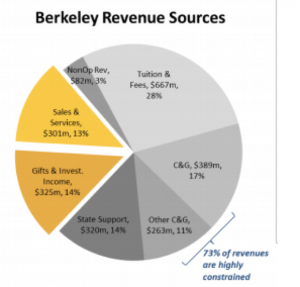Warning: Attempt to read property "ID" on null in /home/davidmor/eoop.davidmorgen.org/wp-content/plugins/subscribe-to-comments/subscribe-to-comments.php on line 194
Endowment
The Blue Outlier
In our previous post discussing a graph we constructed that compared mobility rate, endowments and top-tier public and private schools, there were two points that immediately took our interest. UCLA and UC Berkeley has a much higher mobility rate than any other school listed yet they are towards to lower end of the endowments.
The question we want to ask is: WHY?
We decided to look into the allocation of UC Berkeley’s endowments to see if they were spending their money on certain areas that could attribute to their students’ success.

This was tough. The information I could find online required some sort of financial or banking knowledge, neither of which I have. Apparently, they do not readily hand out information on the specific allocation of endowments online, so it is definitely something we want the Equality of Opportunity Project to get data on.
From what we gathered from the Office of the Chief Financial Officer on UC Berkeley Budget Plant, about $325 million comes from endowments. UC Berkeley receives an endowment of about $1.58 billion. State support nearly matches that amount in revenue sources. Looking at Trish’s post before this, Emory University has a $6.7 billion endowment: over 4X the amount of Berkeley’s. Yet, their spendable portion ($318.2 million) is less than Berkeley’s ($325 million). Interestingly enough, Emory’s mobility rate is 3.6% while UC Berkeley’s rate is 8.8% and UCLA’s is 10.2%. Maybe it is not the endowment itself, but the spending portion of the endowments that go into the schools.
Do endowments really play a factor into success of the students? Keep in mind, the lower end of endowments of the top tier schools are still from $1-3 billion. Obviously, all schools need a certain amount of money to provide students with professors, equipment and resources to guarantee a higher education. However, there might be a threshold to which success can be attributed to endowments. Nevertheless, we can only attempt to point out the patterns we see. To truly study this aspect of colleges, there needs to be access to the information regarding the allocation of these funds.
Comparing Public and Private Schools using Endowments and Economic Mobility
Using Tableau, we were able to capture the trends of endowments, mobility rates, and the type of school all within one graph. In this section of the project, we are focusing on major public and private schools that are nationally ranked as top tier schools:
Public
- UCLA
- UC Berkeley
- University of Virginia
- University of Michigan
- UNC Chapel Hill
- College of William and Mary
- Georgia Institute of Technology
- Texas A&M
- University of Florida
- University of Texas System
- Ohio State
- University of Wisconsin- Madison
Private
- Princeton
- Harvard
- University of Chicago
- Yale
- Columbia
- Stanford
- MIT
- Duke
- University of Pennsylvania
- Johns Hopkins
- Emory
- Vanderbilt
Shiven did a great job incorporating all of the factors we decided to focus on. The green circles represent private colleges while the blue circles represent public colleges. The mobility rate involves the students in the bottom 20% moving to the top 20%. There one major trend occurring. The private schools seem to be correlated with a larger endowment while public schools are associated with smaller endowments. This was a trend we predicted and did not find that surprising. Another trend we saw is that the public schools tended to have lower mobility rates than the private schools, but this trend was not as obvious or strong. Rather, the public schools had a wide range of economic mobility. The private schools on the other hand, stayed within a similar range of mobility rate, regardless of their endowments. Even though public schools tended to have a smaller endowment, when compared to private schools of similar endowments, the public schools sometimes had higher mobility rates than private schools. Again, this is not a strong correlation but it is an interesting point we found in this data. With respects to endowment vs mobility, suprisingly enough we found that in the top tier schools across the nation, those with lower endowments had higher economic mobility.
Something that took our interest immediately was the two blue outliers: UCLA and UC Berkeley. They have rather small endowments compared to the other schools in this analysis, yet their mobility rates exceeded all others, including Harvard with a whopping $32.7 billion a year. We were aware of the California public school system and that their public schools surpassed many other private schools in other states, but we would not have guessed the success of its students was greater than Ivy League schools.
This data now allows us to explore these outliers. First is Harvard, which rakes in 32.7 billion dollars each year, but only has a mobility rate of 1.8%. Second is the UC school system, specifically UCLA and UC Berkeley. Only given about 1/10th of Harvard’s endowments, their mobility rate is 5.6% and 4.9% respectively. It brings into question where these endowments are allocated. Are they given back to the students? Or are they spent elsewhere?
Endowments in Public vs Private School
The Equality of Opportunity Project gathers data on economic mobility of college student. The project includes a wide range of factors, including geography, gender, parent’s income, etc. As a class, we have decided to further analyze some variables that may contribute to a college’s ability to increase income mobility of their students. In this section, we will be focusing on endowments, specifically in top tier private and public colleges. Some of the colleges include Harvard, Emory, Texas A&M, University of Florida, UCLA and UNC Chapel Hill.
Our goal is to first see if there is a correlation between endowments and income mobility with students. Afterwards, we will be comparing public and private schools of similar endowments to see if there might be an advantage to going to one type of school over the other. Additionally, there will be room for future research on how allocation of the endowments, whether it be equity fees, research, athletics, or curriculum, affects the success of the students.
There are a lot of confounding factors that can play into student income mobility, however we are interested in seeing a correlation between the money put into a school (endowment), and the success of the students from those institutions. Are colleges rightfully allocating their endowment to the betterment of current and perspective students during and after college? If not, what are the other possible areas that their endowments may be invested in.
An overarching question for this project is: How do colleges gauge success? Is it based on how well their students do after leaving college or is it based on prestige which has carried on to modern times? Can a school’s endowment be a good indicator as to how well a school is doing?

